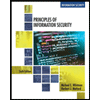Consider the pattern of red and green packet arrivals to a router’s output port queue, shown below. Suppose each packet takes one time slot to be transmitted, and can only begin transmission at the beginning of a time slot after its arrival. Indicate the sequence of departing packet numbers (at t = 1, 2, 3, 4, 5, 6, 7) under Priority scheduling, where red packets have priority over green packets.. Match each time unit (t=1, t=2, t=3 ....) with the number of the packet that was transmitted and thus "departs" at that time unit.
Consider the pattern of red and green packet arrivals to a router’s output port queue, shown below. Suppose each packet takes one time slot to be transmitted, and can only begin transmission at the beginning of a time slot after its arrival. Indicate the sequence of departing packet numbers (at t = 1, 2, 3, 4, 5, 6, 7) under Priority scheduling, where red packets have priority over green packets.. Match each time unit (t=1, t=2, t=3 ....) with the number of the packet that was transmitted and thus "departs" at that time unit.
Principles of Information Security (MindTap Course List)
6th Edition
ISBN:9781337102063
Author:Michael E. Whitman, Herbert J. Mattord
Publisher:Michael E. Whitman, Herbert J. Mattord
Chapter6: Security Technology: Access Controls, Firewalls, And Vpns
Section: Chapter Questions
Problem 2RQ
Related questions
Question
Consider the pattern of red and green packet arrivals to a router’s output port queue, shown below. Suppose each packet takes one time slot to be transmitted, and can only begin transmission at the beginning of a time slot after its arrival. Indicate the sequence of departing packet numbers (at t = 1, 2, 3, 4, 5, 6, 7) under Priority scheduling, where red packets have priority over green packets.. Match each time unit (t=1, t=2, t=3 ....) with the number of the packet that was transmitted and thus "departs" at that time unit.
![Consider the pattern of red and green packet arrivals to a router's output port queue, shown below. Suppose each packet takes one time slot to be
transmitted, and can only begin transmission at the beginning of a time slot after its arrival. Indicate the sequence of departing packet numbers (at t = 1, 2, 3,
4, 5, 6, 7) under Priority scheduling, where red packets have priority over green packets.. Match each time unit (t=1, t=2, t=3 ....) with the number of the
packet that was transmitted and thus "departs" at that time unit.
[Note: You can find more examples of problems similar to this here B.]
arrivals
packet
in service
departures
1 234
5
2
67
?? ?????
5
6
t](/v2/_next/image?url=https%3A%2F%2Fcontent.bartleby.com%2Fqna-images%2Fquestion%2F10e465a6-7588-4fdb-8c02-7922f29b53b5%2F9e38011c-f073-4af1-ad2b-1f27b2646735%2Fauc82cr_processed.png&w=3840&q=75)
Transcribed Image Text:Consider the pattern of red and green packet arrivals to a router's output port queue, shown below. Suppose each packet takes one time slot to be
transmitted, and can only begin transmission at the beginning of a time slot after its arrival. Indicate the sequence of departing packet numbers (at t = 1, 2, 3,
4, 5, 6, 7) under Priority scheduling, where red packets have priority over green packets.. Match each time unit (t=1, t=2, t=3 ....) with the number of the
packet that was transmitted and thus "departs" at that time unit.
[Note: You can find more examples of problems similar to this here B.]
arrivals
packet
in service
departures
1 234
5
2
67
?? ?????
5
6
t
![Consider the pattern of red and green packet arrivals to a router's output port queue, shown below. Suppose each packet takes one time slot to be
transmitted, and can only begin transmission at the beginning of a time slot after its arrival. Indicate the sequence of departing packet numbers (at t = 1, 2, 3,
4, 5, 6, 7) under Priority scheduling, where red packets have priority over green packets.. Match each time unit (t=1, t=2, t=3 ....) with the number of the
packet that was transmitted and thus "departs" at that time unit.
[Note: You can find more examples of problems similar to this here B.]
arrivals
packet
in service
departures
1 234
5
2
67
?? ?????
5
6
t](/v2/_next/image?url=https%3A%2F%2Fcontent.bartleby.com%2Fqna-images%2Fquestion%2F10e465a6-7588-4fdb-8c02-7922f29b53b5%2F9e38011c-f073-4af1-ad2b-1f27b2646735%2F5jht3s_processed.png&w=3840&q=75)
Transcribed Image Text:Consider the pattern of red and green packet arrivals to a router's output port queue, shown below. Suppose each packet takes one time slot to be
transmitted, and can only begin transmission at the beginning of a time slot after its arrival. Indicate the sequence of departing packet numbers (at t = 1, 2, 3,
4, 5, 6, 7) under Priority scheduling, where red packets have priority over green packets.. Match each time unit (t=1, t=2, t=3 ....) with the number of the
packet that was transmitted and thus "departs" at that time unit.
[Note: You can find more examples of problems similar to this here B.]
arrivals
packet
in service
departures
1 234
5
2
67
?? ?????
5
6
t
Expert Solution
This question has been solved!
Explore an expertly crafted, step-by-step solution for a thorough understanding of key concepts.
This is a popular solution!
Trending now
This is a popular solution!
Step by step
Solved in 3 steps

Knowledge Booster
Learn more about
Need a deep-dive on the concept behind this application? Look no further. Learn more about this topic, computer-science and related others by exploring similar questions and additional content below.Recommended textbooks for you

Principles of Information Security (MindTap Cours…
Computer Science
ISBN:
9781337102063
Author:
Michael E. Whitman, Herbert J. Mattord
Publisher:
Cengage Learning

Principles of Information Security (MindTap Cours…
Computer Science
ISBN:
9781337102063
Author:
Michael E. Whitman, Herbert J. Mattord
Publisher:
Cengage Learning